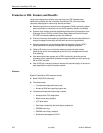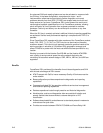
About the FrameSaver DSL Unit
1-8
9783-A2-GB20-00
July 2000
Basic Features
The FrameSaver DSL unit provides the following features:
H Easy Installation. When AutoBaud is used, no configuration is required.
SNMP options may be modified if desired to provide security and enable
traps.
H Frame Relay Aware Management. Supports diagnostic and network
management features over the frame relay network. The unit’s frame relay
capability also supports:
— Inband management channels over the frame relay network using
dedicated PVCs.
— Unique nondisruptive diagnostics.
— CIR monitoring on a PVC basis.
— Multiple PVCs on an interface.
— Multiplexing management PVCs with user data PVCs.
— Multiplexing multiple PVCs going to the same location onto a single
network PVC.
H Router-Independence. Unique diagnostics, performance monitoring,
PVC-based in-band network management, and SNMP connectivity is not
dependent upon external routers, cables, or LAN adapters.
H Inverse ARP and Standard RIP Support. Provides Inverse ARP (Address
Resolution Protocol) support so the frame relay router at one end of a
management PVC can acquire the IP address of a FrameSaver unit at the
other end of the PVC. Standard RIP (Routing Information Protocol) allows the
router to automatically learn the routes to all FrameSaver units connected to
that FrameSaver unit.
H Security. Provides multiple levels of security to prevent unauthorized access
to the unit.
H Auto-Configuration. Provides the following automatic configuration features:
— CIR Determination – For automatic recalculation of the committed rate
measurement interval (T
c
) and excess burst size (B
e
) when a DLCI’s CIR
changes.
— Excess burst size (B
e
) and committed burst size (B
c
) are recalculated
when Committed Burst Size B
c
(Bits) is set to CIR. The committed rate
measurement interval (T
c
) is recalculated when Committed Burst Size B
c
(Bits) is set to Other.
H Configurable FTP Transfer Rate. Allows you to control the transmit rate
used for downloading from the FrameSaver unit and uploading user history
statistics to an NMS (Network Management System) via the COM port
connection or a management PVC so the data can be transferred as a
background task using the standard File Transfer Protocol (FTP) over
extended periods of time using low bandwidth.


















